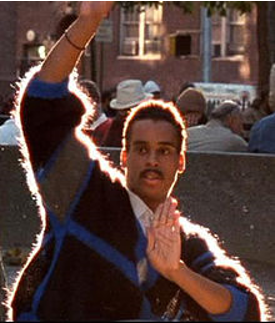
Voguing in the ‘real’ world
Since voguing started as a dance style in the 1980s, it has changed: it has evolved, it grew and it became more well-known (Bailey E. A., 2009). To investigate whether and how voguing has changed in the offline world, that is not an imaginary, simulated, theoretical or online world, two important, well-known and skilled voguers will be presented here. The first voguer we will investigate is a man called Willi Ninja (1961-2006) who is said to be the godfather of voguing. He came from the original ballroom scene in Harlem and started his own house called: The Legendary House of Ninja. In 2006 he died because of AIDS-related heart failure at the age of 45. The second voguer is a Swedish woman called Anne Ninja, who is active and eminent in the present. She is a member of The Legendary House of Ninja, and attributes Willi Ninja as her icon.
Take one: Willi Ninja
Willi Ninja was a colored homosexual man, and considered one of the best voguers up until today. He was comfortable in almost all the different styles and genres that voguing offered. Willi was also a very determined man; his goal was to bring voguing all over the world. "Voguing had been around for years, but Willi Ninja brought it to a level of visibility and perfection in performance that no one had ever reached before, said Sally Sommer, a professor of dance at Florida State University." (Ogunnaike, Lola, 2006)

Figure 7: Willi Ninja in "Paris is Burning".
In an interview with Joan Rivers, Willi tells us about his loving mother who took him to ballet shows and nurtured his femininity. He even said he never came out of the closet to her; she confronted him (Rivers, 1991). He finished high school, dropped out of college and then finished beauty school. In the early 1980s, Willi was part of a dance group: ‘The Video Pretenders’. He and some friends went to clubs and would imitate dance moves from famous people on television. Soon after this, Willi wanted to make his own choreography, so shortly after, he made his debut in the Harlem ballroom scene (Herrera, s.a.).
Dance is not just moving your body. It’s bringing your inner spirit out and letting everybody else enjoy it with you.
Willi Ninja became famous within the ballroom culture. He was a very good dancer and definitely had the right attitude. Willi was successful in his world, and he started his own legendary 'House of Ninja’ in 1982 . His ‘children’, the boys and girls he ‘adopted’ in his house of Ninja, looked up to him. At the end of the 1980s fashion designers and art inspirers (e.g. Malcom McLaren) started to take interest in the Harlem ballroom scene—it remained local and not famous until Paris is Burning came out in 1990. This documentary featuring Willi Ninja provided him with success for the rest of his life. Willi became choreographer, dancer, musician, runway model and modeling coach. "An androgynous, self-described 'butch queen,' Willi Ninja taught voguing throughout Europe and Japan, modeled in runway shows for the fashion designers Jean Paul Gaultier and Thierry Mugler and danced in music videos" (Ogunnaike, Lola, 2006).
Take two: Anna Ninja
At the age of fourteen Anna Ninja (real name: Anna Näsström) started dancing. Later on, she studied modern dance. When she moved to New York City she was introduced to voguing through school. She was taught about the unique dance and heard about Willi Ninja, who later became her idol. She immediately fell in love with the culture: she loved the attitude, the freedom, the inspiration and the talent. She started visiting events and encountered the legendary House of Ninja. She became the first European member (Fernandez, 2016).
'I think vogue has been used a lot in the mainstream scene, but this is only the actual dance, and not the culture.' (Anna Ninja)
Together with Bianca Ninja, another member of House of Ninja, she wanted to bring the ballroom scene to Sweden, and bring the European ballroom scene together. Together with Aviance Milan and Peter Wallenberg, they organized The World of Vogue Ball in Stockholm (Fernandez, 2016).
"Anna Ninja is a dancer/choreographer/teacher based in Sweden. Currently she is working in Swedish choreographer Fredrik 'Benke' Rydman’s 'Stop. Play. Rewind', playing nov-feb at Dansens Hus in Stockholm. Besides working in production she judges and participates in battles internationally, freelances in dance, modeling and different art projects. Anna in the first European member of "The Legendary House of Ninja" & also part of the Swedish based 'P*fect dance company'" (Näsström, 2016).

Figure 8: Anna Ninja.
In an interview with Vogue Anna tells us something more about her vision of voguing:
"We all fight some kind of fight regarding fitting into a society that isn’t built for everyone. Vogue is accepting of all bodies, all genders, all sexualities, and all ethnicities. This indeed is saying something. For me, vogue has been a place where I get to take back my body, and move however I want as a woman, for myself. You get to express your sexuality, femininity and body in whatever way you wish, and the confidence and love for yourself is praised by the community" (Fernandez, 2016).
When the interviewer asks Anna about the voguing culture as started by the afro American and Hispanic drag queens and today being used for mainstream messages and events, Anna replies by saying there is a difference in just the dance and the ballroom culture. The dance itself can be used for different purposes and even more mainstream means; the culture however is still authentic. This does not mean voguing is not meant for everybody. She explains: "We all fight some kind of fight regarding fitting into a society that isn’t built for everyone. Vogue is accepting of all bodies, all genders, all sexualities, and all ethnicities" (Fernandez, 2016).
The end
Both dancers stand firmly behind their point that voguing is more than the dance itself: the dance is part of a culture. Willi says it’s about your inner spirit and your body connecting in what they want to do, and Anna says it is being free to move how you want to move. Both of them express that you can use the dance to express your femininity the way you want to. It is about belonging somewhere and being rewarded for loving yourself. Both of them are members of a house which is part of the ballroom culture. These houses still work the same way as they did in the 1980s, though they have a broader reach now. Instead of only existing in Harlem, New York there are houses throughout Europe, the U.S.A, Australia, Russia, etc.. According to Anna, the dance itself, however, has been used for commercial goals. This is something different than the ballroom culture itself.
References
Bailey, E. A. (2009, April 23). Constructing Home and Family: How the Ballroom Community Supports African American GLBTQ Youth in the Face of HIV/AIDS. Retrieved November 30, 2016, from NCBI.
Fernandez, D. (2016, August). In Vogue: An Interview With Anne Ninja. Retrieved November 29, 2016, from Totally Stockholm.
Herrera, A. (n.a.). Willi Ninja. Retrieved November 28, 2016, from OUTHISTORY.
Ogunnaike, Lola. (2006, September 6). Willi Ninja, 45, Self-Created Star Who Made Vogueing Into an Art, Dies. Retrieved November 29, 2016, from New York Times.
Rivers, J. (Director). (1991). Paris is Burning cast on The Joan Rivers Show [Motion Picture]. Retrieved November 28, 2016.